Design Method for Low-Carbon Fly Ash Concrete Considering Strength, Form Removal Time, and Carbonation Durability Life
Abstract
:1. Introduction
2. Evaluation and Parameters Analysis for Strength
2.1. Methods and Materials
2.2. Regression and Parameter Analysis for Compressive Strength
3. Low-CO2 Optimal Design of Fly Ash Blended Concrete
3.1. Goal of Optimization Design
3.2. Constraints on Optimal Design
3.2.1. Water Content
3.2.2. Range of Ingredient Ratios
3.2.3. Carbonation Durability
3.2.4. Construction Requirements
3.3. Algorithm for Optimal Design
4. Case Analysis of Optimized Design
4.1. Design Cases
4.2. Results and Analysis of Design Cases
5. Discussion
6. Conclusions
- (1)
- Design Case 1 assumes that the 28-day design strength of concrete is 30 MPa and does not consider the requirements for construction and carbonation durability. The optimized design result is that the masses of cement and fly ash are 167.70 and 204.84 kg/m3, respectively. In Case 1, the water–binder ratio is 0.45 (which is located in the studied water–binder ratio range between 0.3 and 0.5), and the mass ratio of the fly ash to binder is 0.55 (reaching the upper limit of fly ash substitution). This design example illustrates that the use of concrete with a high level of fly ash can indeed reduce CO2 emissions.
- (2)
- Design Case 2 assumes that the 28-day design strength is 30 MPa and that the 7-day design strength is 21 MPa. The construction requirements are considered, but the durability requirements are ignored. The result of the optimized design is that the masses of cement and fly ash are 193.82 and 236.89 kg/m3, respectively; the water–binder ratio of Mix 2 is 0.39 (which is located in the studied range of the water–binder ratio between 0.3 and 0.5), and the mass ratio of the fly ash to binder is 0.55 (reaching the upper limit of the fly ash replacement amount). For Mix 2, its 7-day strength is 21 MPa, which is equal to the design strength, but its 28-day real strength is 41.43 MPa, which is higher than the design strength of 30 MPa. This shows that the early strength development is slow due to the low reactivity of fly ash. When early formwork removal is required, the strength needs to be increased for 28 days to meet the construction requirements.
- (3)
- Case 3 assumes that the 28-day design strength is 30 MPa and that the 7-day design strength is 21 MPa. After the formwork is removed at seven days, the material is exposed to the surrounding environment. For Case 3, the result of the optimized design is that the masses of cement and fly ash are 428.09 and 138.56 kg/m3, respectively; the water–binder ratio of Mix 3 is 0.30 (reaching the lower limit of the studied water–binder ratio), and the mass ratio between the fly ash and binder is 0.24 (which is located between the upper and lower limits of the fly ash substitution rate). For Mix 3, its 7-day and 28-day real strengths are 58.61 and 80.29 MPa, respectively, which are higher than the design requirements of 21 and 30 MPa, respectively. This is because of the carbonation durability requirements. After 50 years of use, the carbonation depth is 25 mm, which is equal to the thickness of the protective layer.
- (4)
- Case 4 assumes that the 28-day design strength is 30 MPa and that the 7-day design strength is 21 MPa. The material is only exposed to the surrounding environment after the formwork is removed at 28 days. For Case 4, the optimized design result is that the masses of cement and fly ash are 221.34 and 270.53 kg/m3, respectively; the water–binder ratio is 0.34 (which is between the upper and lower limits), and the mass ratio of the fly ash to binder is 0.55 (which is equal to the upper limit). For Mix 4, its 7-day and 28-day real strengths are 26.98 and 47.22 MPa, respectively, which are higher than the design requirements of 21 and 30 MPa, respectively. This is also due to the carbonation durability requirements. After 50 years of use, the carbonation depth is 25 mm, which is also equal to the thickness of the protective layer. From Case 3 to Case 4, it is shown that increasing the curing time before carbonation is one of the effective methods that can be used to produce low-carbon fly ash concrete.
Author Contributions
Funding
Data Availability Statement
Conflicts of Interest
References
- Pang, B.; Zheng, H.; Jin, Z.; Hou, D.; Zhang, Y.; Song, X.; Sun, Y.; Liu, Z.; She, W.; Yang, L.; et al. Inner superhydrophobic materials based on waste fly ash: Microstructural morphology of microetching effects. Compos. Part B Eng. 2024, 268, 111089. [Google Scholar] [CrossRef]
- Bai, B.; Chen, J.; Bai, F.; Nie, Q.; Jia, X. Corrosion effect of acid/alkali on cementitious red mud-fly ash materials containing heavy metal residues. Environ. Technol. Innov. 2024, 33, 103485. [Google Scholar] [CrossRef]
- Li, Z.; Gao, M.; Lei, Z.; Tong, L.; Sun, J.; Wang, Y.; Wang, X.; Jiang, X. Ternary cementless composite based on red mud, ultra-fine fly ash, and GGBS: Synergistic utilization and geopolymerization mechanism. Case Stud. Constr. Mater. 2023, 19, e02410. [Google Scholar] [CrossRef]
- Campos, H.F.; Klein, N.S.; Marques Filho, J. Proposed mix design method for sustainable high-strength concrete using particle packing optimization. J. Clean. Prod. 2020, 265, 121907. [Google Scholar] [CrossRef]
- Luan, C.; Shi, X.; Zhang, K.; Utashev, N.; Yang, F.; Dai, J.; Wang, Q. A mix design method of fly ash geopolymer concrete based on factors analysis. Constr. Build. Mater. 2021, 272, 121612. [Google Scholar] [CrossRef]
- Wang, X.-Y.; Park, K.-B. Analysis of compressive strength development of concrete containing high volume fly ash. Constr. Build. Mater. 2015, 98, 810–819. [Google Scholar] [CrossRef]
- Zhang, M.; Wu, Y.; Li, Y.; Zhou, R.; Yu, H.; Zhu, X.; Quan, H.; Li, Y. Risk assessment for the long-term stability of fly ash-based cementitious material containing arsenic: Dynamic and semidynamic leaching. Environ. Pollut. 2024, 345, 123361. [Google Scholar] [CrossRef] [PubMed]
- Nilimaa, J.; Gamil, Y.; Zhaka, V. Formwork Engineering for Sustainable Concrete Construction. CivilEng 2023, 4, 1098–1120. [Google Scholar] [CrossRef]
- Fasihihour, N.; Abad, J.M.N.; Karimipour, A.; Mohebbi, M.R. Experimental and numerical model for mechanical properties of concrete containing fly ash: Systematic review. Measurement 2022, 188, 110547. [Google Scholar] [CrossRef]
- Han, S.-H.; Kim, J.-K.; Park, Y.-D. Prediction of compressive strength of fly ash concrete by new apparent activation energy function. Cem. Concr. Res. 2003, 33, 965–971. [Google Scholar]
- Hwang, K.; Noguchi, T.; Tomosawa, F. Prediction model of compressive strength development of fly-ash concrete. Cem. Concr. Res. 2004, 34, 2269–2276. [Google Scholar] [CrossRef]
- Krishnya, S.; Herath, C.; Elakneswaran, Y.; Gunasekara, C.; Law, D.W.; Setunge, S. Modeling of hydration products and strength development for high-volume fly ash binders. Constr. Build. Mater. 2022, 320, 126228. [Google Scholar] [CrossRef]
- Yeh, I.-C. Modeling of strength of high-performance concrete using artificial neural networks. Cem. Concr. Res. 1998, 28, 1797–1808. [Google Scholar] [CrossRef]
- Sevim, U.K.; Bilgic, H.H.; Cansiz, O.F.; Ozturk, M.; Atis, C.D. Compressive strength prediction models for cementitious composites with fly ash using machine learning techniques. Constr. Build. Mater. 2021, 271, 121584. [Google Scholar] [CrossRef]
- Roshani, M.M.; Kargar, S.H.; Farhangi, V.; Karakouzian, M. Predicting the Effect of Fly Ash on Concrete’s Mechanical Properties by ANN. Sustainability 2021, 13, 1469. [Google Scholar] [CrossRef]
- Song, H.; Ahmad, A.; Farooq, F.; Ostrowski, K.A.; Maślak, M.; Czarnecki, S.; Aslam, F. Predicting the compressive strength of concrete with fly ash admixture using machine learning algorithms. Constr. Build. Mater. 2021, 308, 125021. [Google Scholar] [CrossRef]
- Lim, C.-H.; Yoon, Y.-S.; Kim, J.-H. Genetic algorithm in mix proportioning of high-performance concrete. Cem. Concr. Res. 2004, 34, 409–420. [Google Scholar] [CrossRef]
- Yeh, I.-C. Computer-aided design for optimum concrete mixtures. Cem. Concr. Compos. 2007, 9, 193–202. [Google Scholar] [CrossRef]
- Wang, X.-Y. Simulation for optimal mixture design of low-CO2 high-volume fly ash concrete considering climate change and CO2 uptake. Cem. Concr. Compos. 2019, 104, 103408. [Google Scholar] [CrossRef]
- Wang, X.Y. Optimal Design of the Cement, Fly Ash, and Slag Mixture in Ternary Blended Concrete Based on Gene Expression Programming and the Genetic Algorithm. Materials 2019, 12, 2448. [Google Scholar] [CrossRef]
- Papadakis, V.G.; Antiohos, S.; Tsimas, S. Supplementary cementing materials in concrete, Part II: A fundamental estimation of the efficiency factor. Cem. Concr. Res. 2002, 32, 1533–1538. [Google Scholar] [CrossRef]
- Papadakis, V.G.; Tsimas, S. Supplementary cementing materials in concrete, Part I: Efficiency and design. Cem. Concr. Res. 2002, 32, 1525–1532. [Google Scholar] [CrossRef]
- Lam, L.; Wong, Y.L.; Poon, C.S. Effect of fly ash and silica fume on compressive and fracture behaviors of concrete. Cem. Concr. Res. 1998, 28, 271–283. [Google Scholar] [CrossRef]
- 7D-Software Auto2Fit, 5.5; 7D-Software: Hamburg, Germany, 2010.
- Bonavetti, V.; Donza, H.; Menéndez, G.; Cabrera, O.; Irassar, E.F. Limestone filler cement in low w/c concrete: A rational use of energy. Cem. Concr. Res. 2003, 33, 865–871. [Google Scholar] [CrossRef]
- Mehta, P.; Monterio, P. Concrete-Microstructure-Properties-and-Materials, 3rd ed.; McGraw-Hill Companies: New York, NY, USA, 2006. [Google Scholar]
- Demis, S.; Efstathiou, M.P.; Papadakis, V.G. Computer-aided modeling of concrete service life. Cem. Concr. Compos. 2014, 47, 9–18. [Google Scholar] [CrossRef]
- Oh, B.H.; Jang, S.Y. Prediction of diffusivity of concrete based on simple analytic equations. Cem. Concr. Res. 2004, 34, 463–480. [Google Scholar] [CrossRef]
- Zhang, D.; Ghouleh, Z.; Shao, Y. Review on carbonation curing of cement-based materials. J. CO2 Util. 2017, 21, 119–131. [Google Scholar] [CrossRef]
- MathWorks. MATLAB, R2023b; MathWorks: Portola Valley, CA, USA, 2024. [Google Scholar]
- Stewart, M.G.; Wang, X.; Nguyen, M.N. Climate change impact and risks of concrete infrastructure deterioration. Eng. Struct. 2011, 33, 1326–1337. [Google Scholar] [CrossRef]
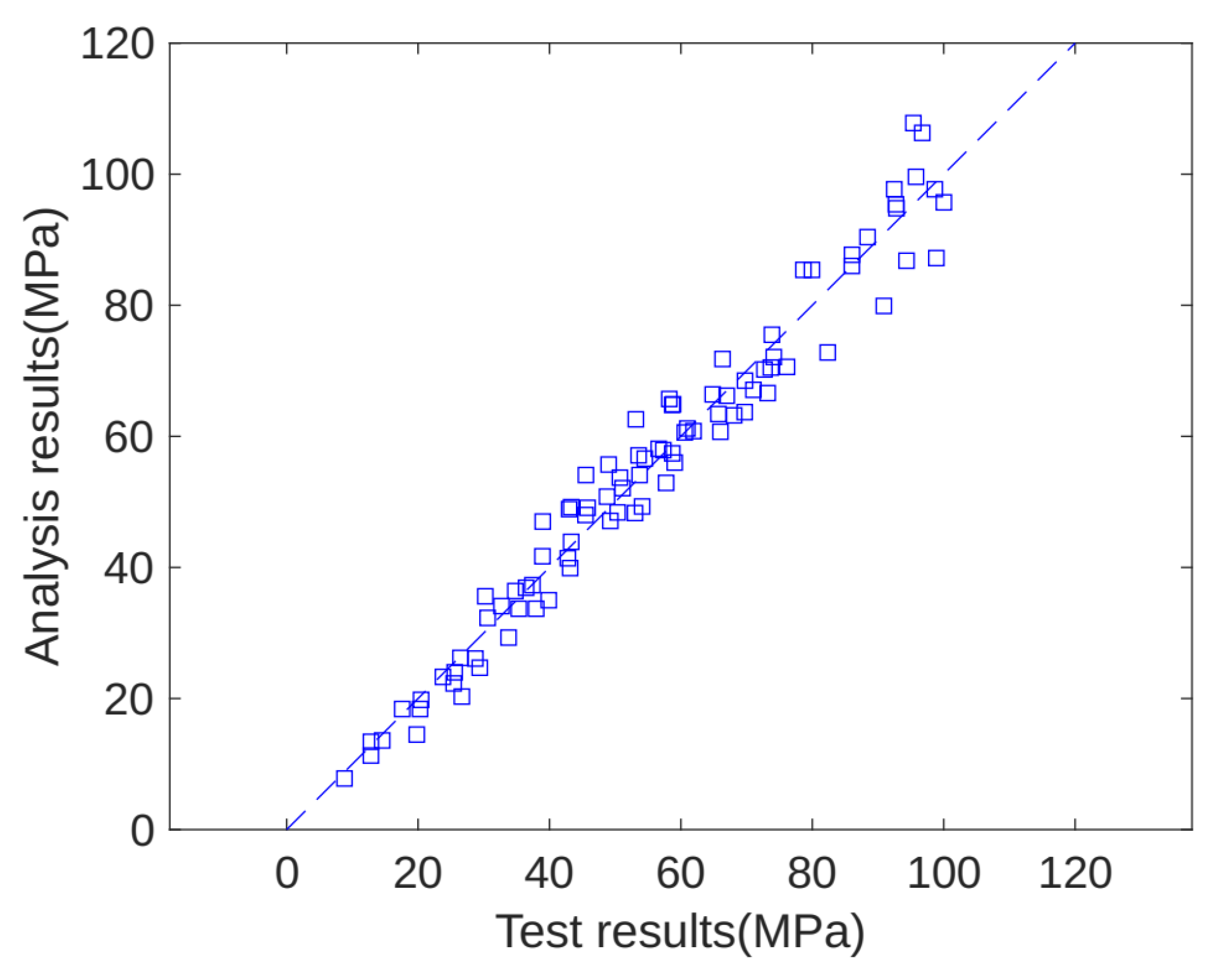
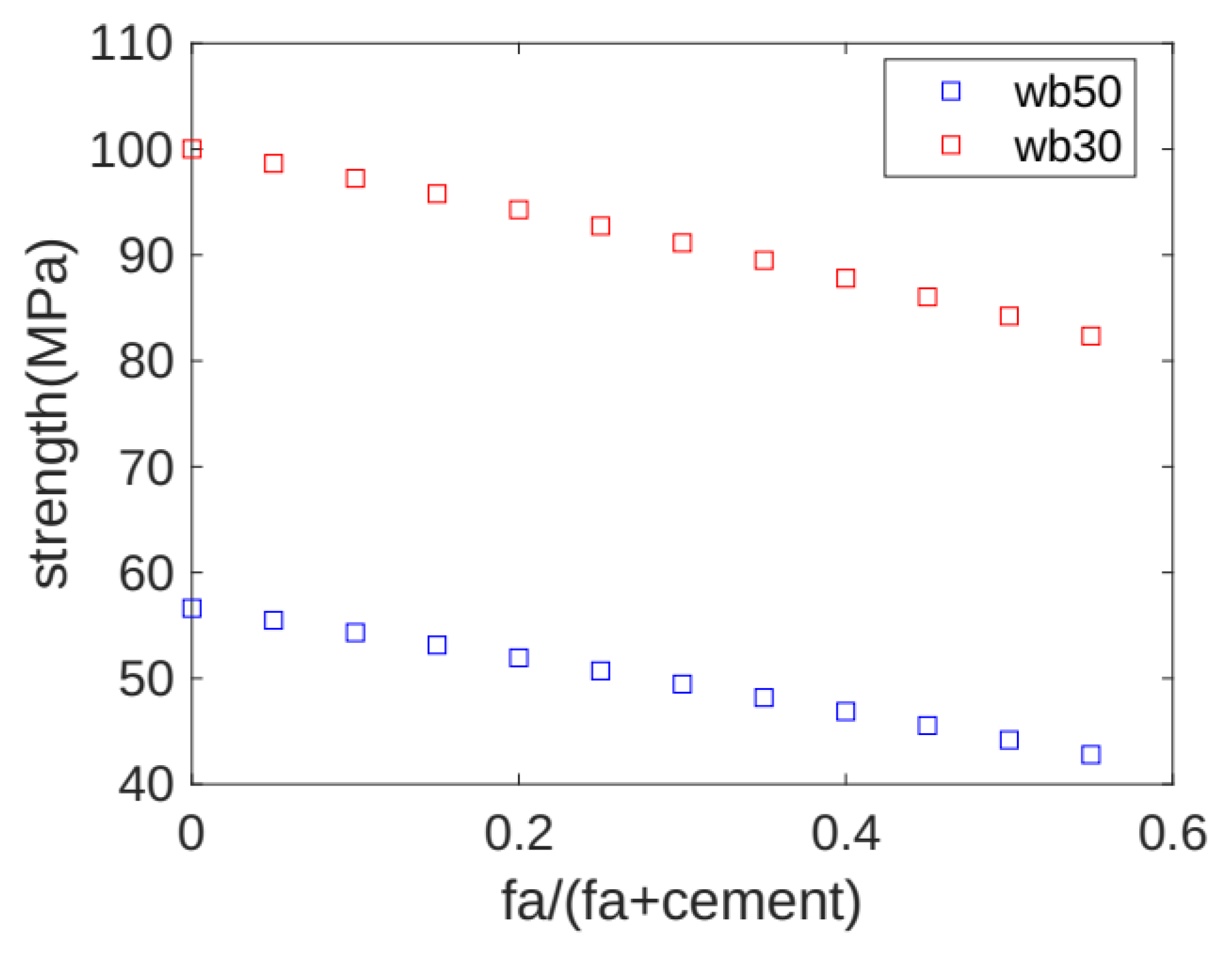
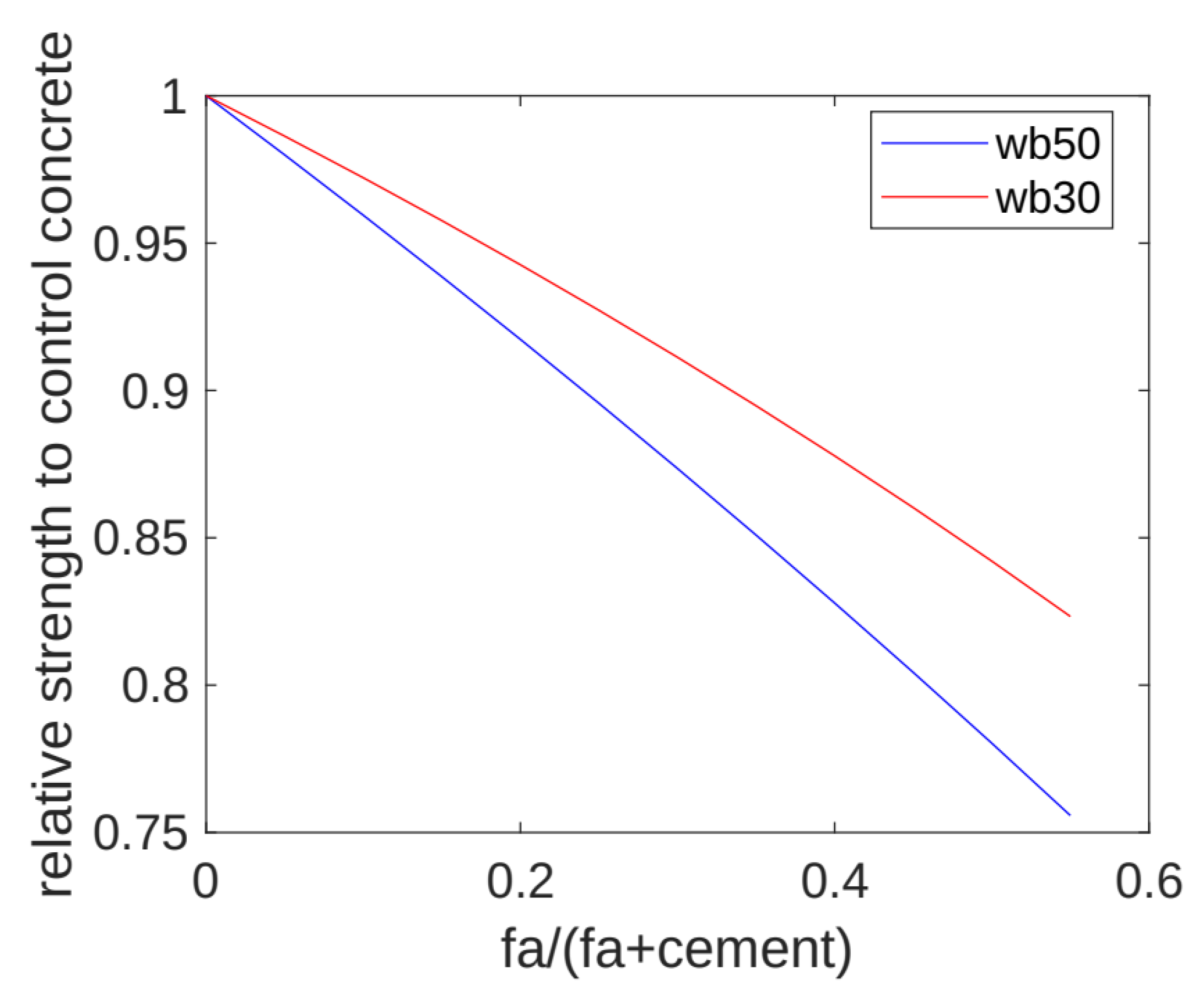
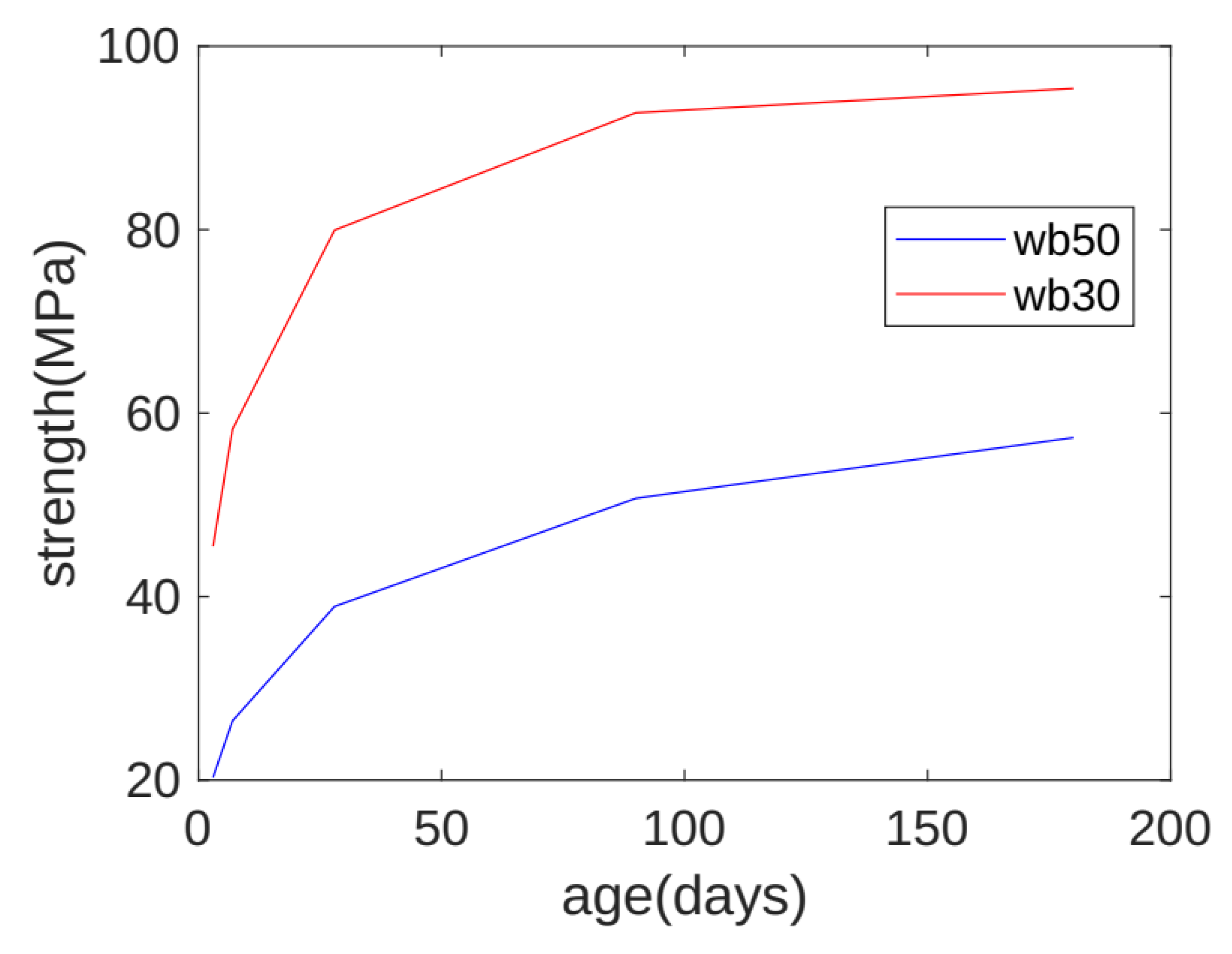
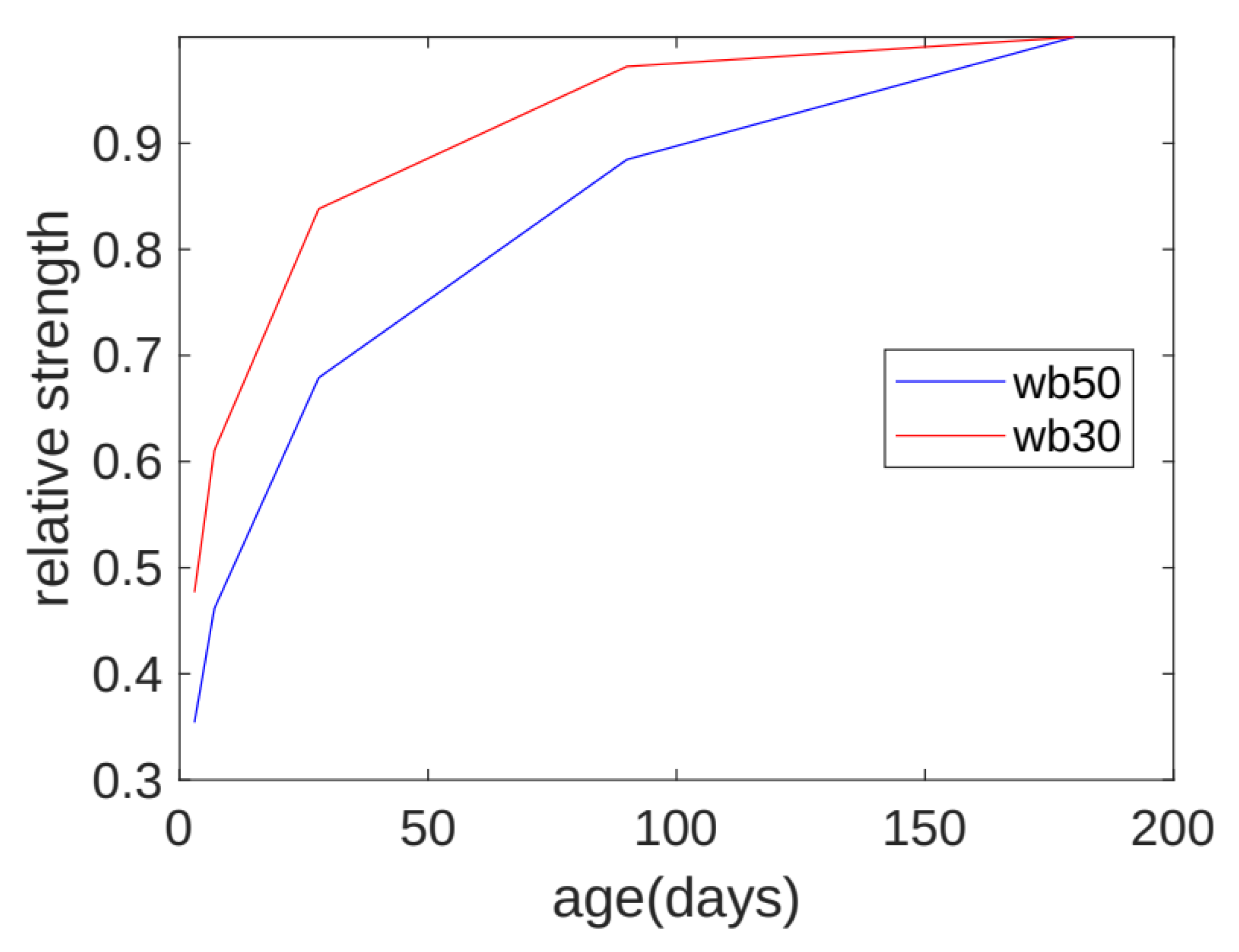
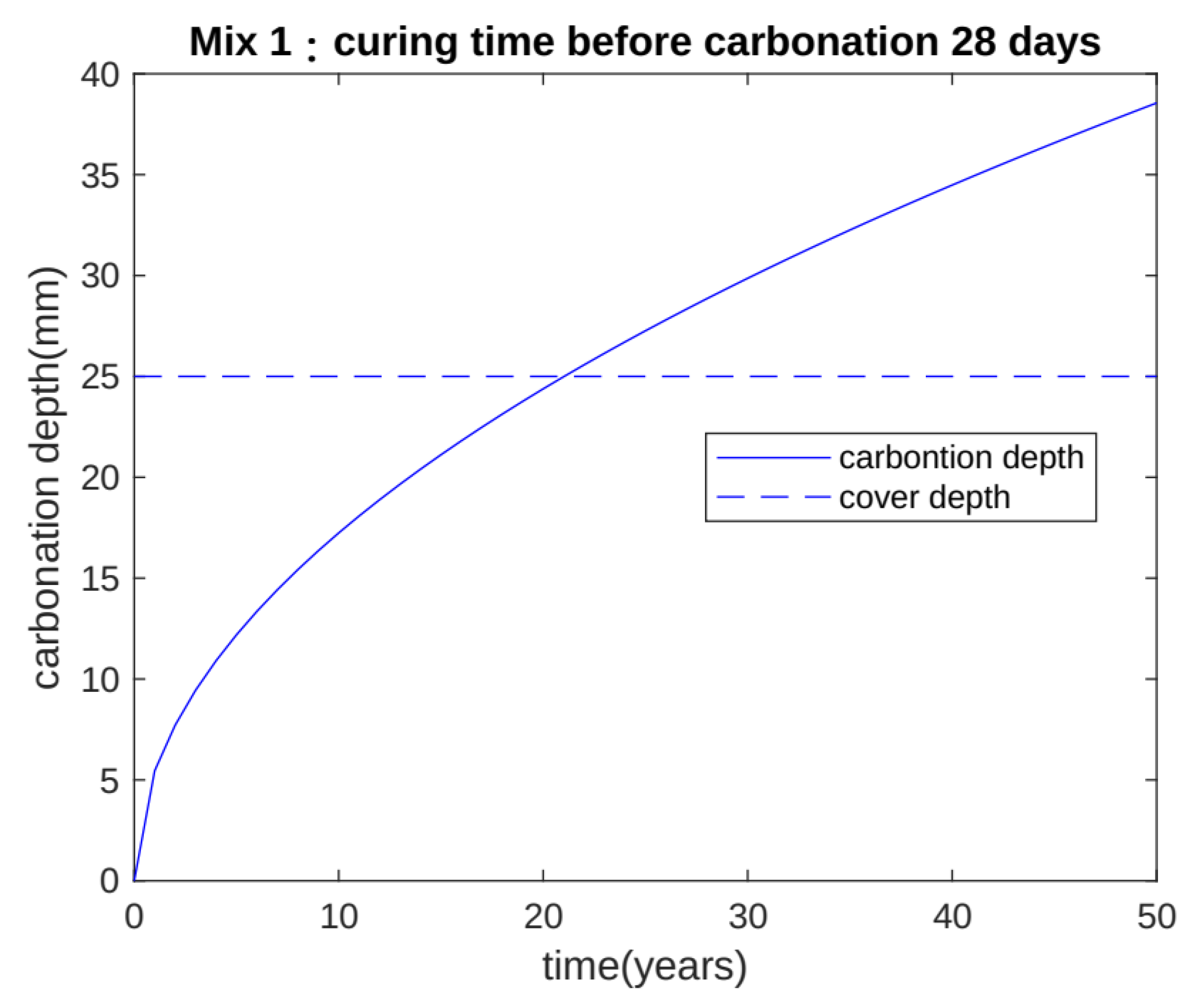

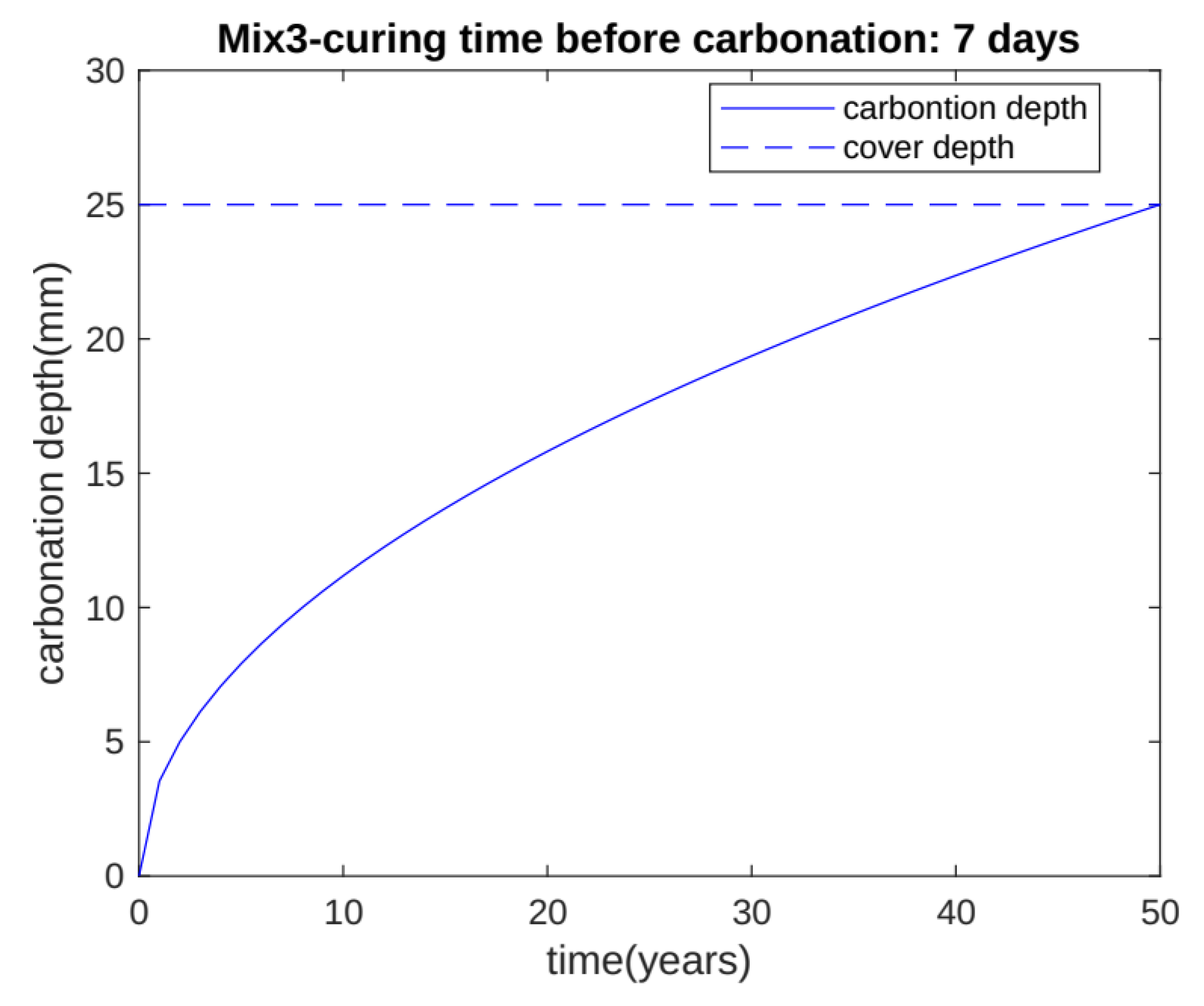
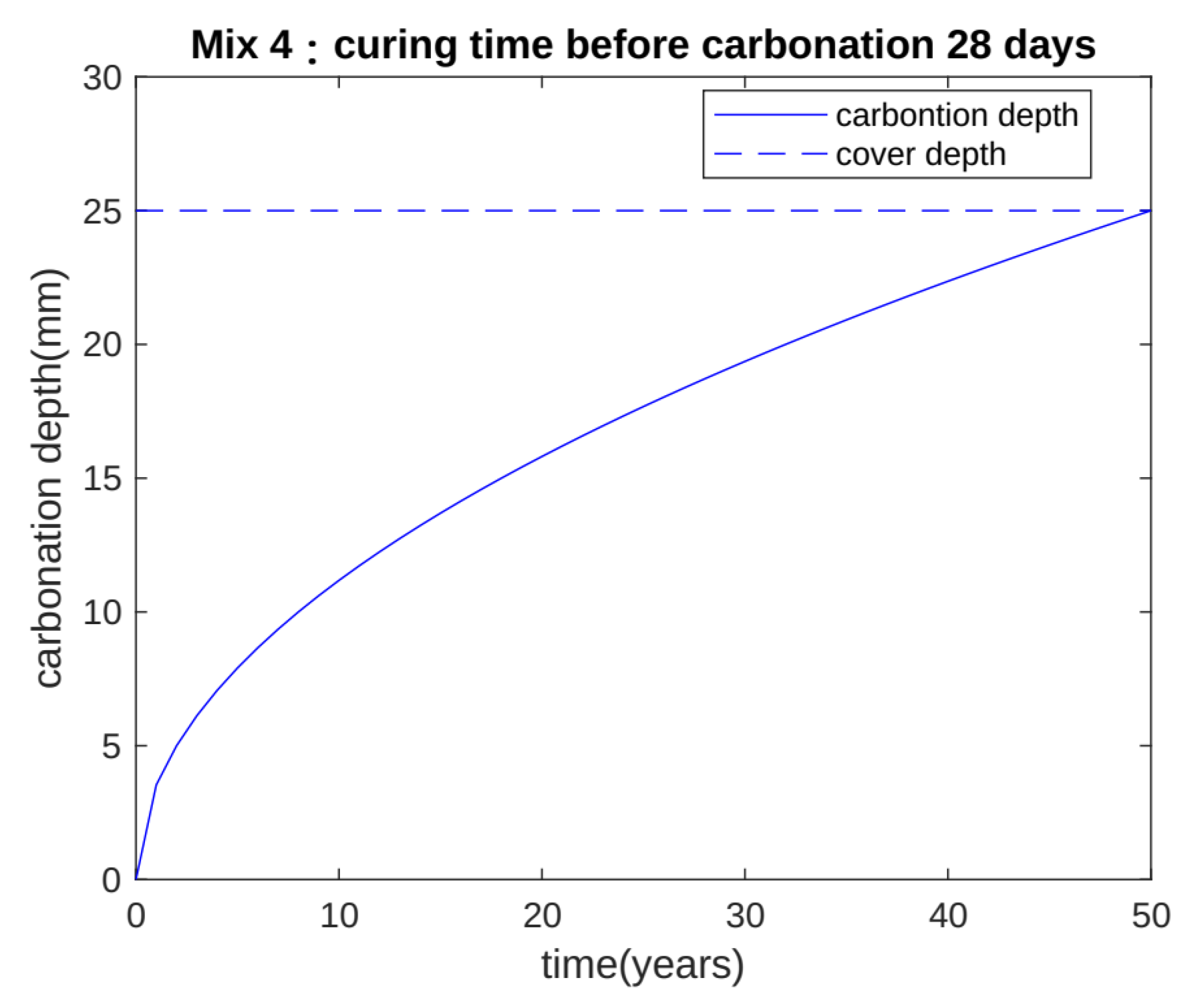
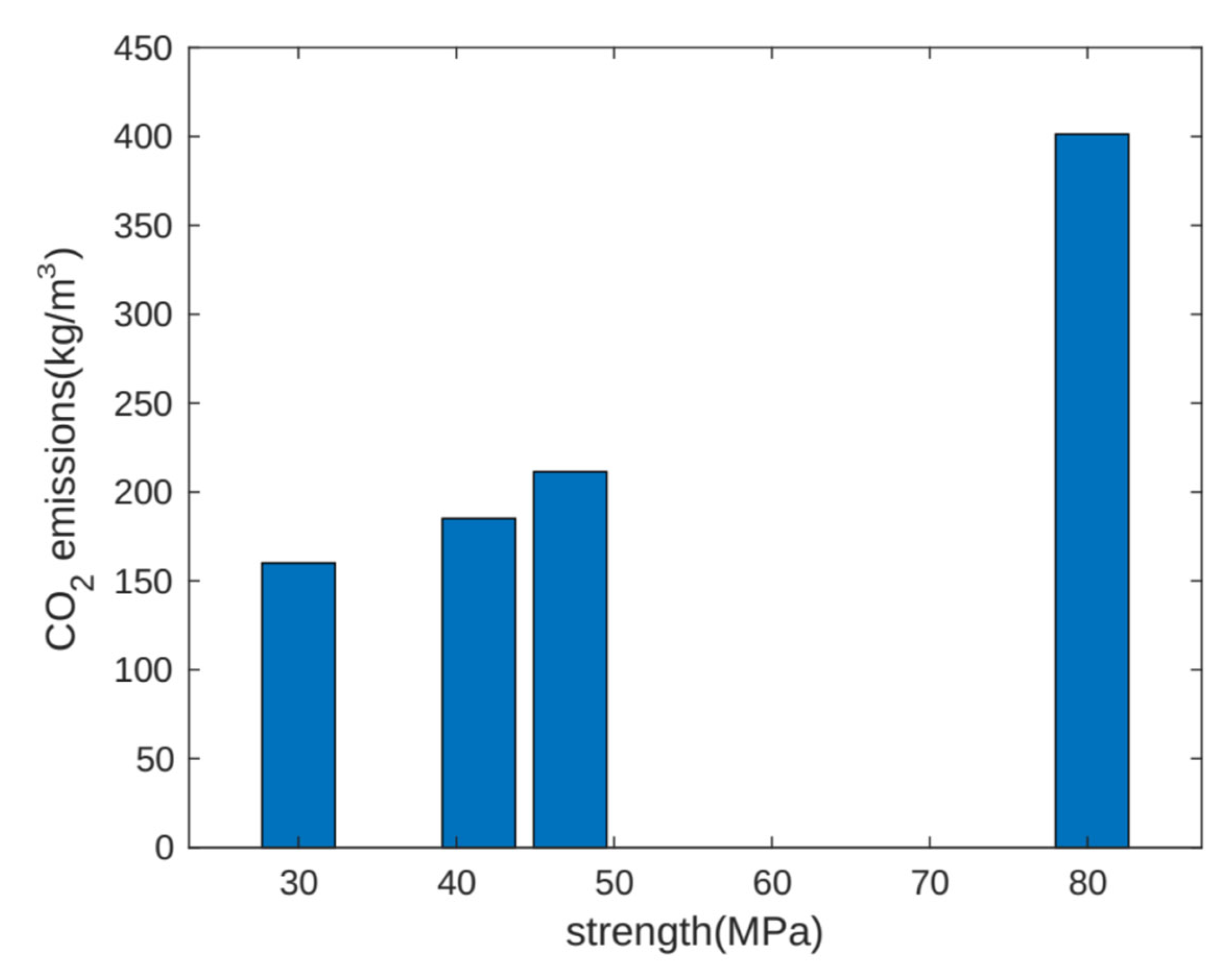
| Coefficients | Values |
|---|---|
| p1 | 6.35297417900102 |
| p2 | 116,952,873.38987 |
| p3 | −1,050,245,908.58601 |
| p4 | −991,527.590492115 |
| p5 | 1,107,321,066.20182 |
| p6 | −1,181,907,559.08431 |
| p7 | −512,788,823.508165 |
| p8 | 12,880,913.9775729 |
| p9 | −20.5249682079566 |
| Water content | 170 kg/m3 |
| Water/binder ratio | [0.3, 0.5] |
| Fly ash/binder ratio | [0, 0.55] |
| Carbonation depth at 50 years | ≤cover depth |
| Strength at concrete formwork removal time | ≥design strength 70% |
| 28-Day Design Strength (MPa) | 7-Day Design Strength (MPa) | Curing Time before Carbonation (Days) | |
|---|---|---|---|
| Mix 1 | 30 | - | - |
| Mix 2 | 30 | 21 | - |
| Mix 3 | 30 | 21 | 7 |
| Mix 4 | 30 | 21 | 28 |
| Water (kg/m3) | Cement (kg/m3) | Fly Ash (kg/m3) | Water/Binder Ratio | Fly Ash/Binder Ratio | |
|---|---|---|---|---|---|
| Mix 1 | 170 | 167.60 | 204.84 | 0.45 | 0.55 |
| Mix 2 | 170 | 193.82 | 236.89 | 0.39 | 0.55 |
| Mix 3 | 170 | 428.09 | 138.56 | 0.30 | 0.24 |
| Mix 4 | 170 | 221.34 | 270.53 | 0.34 | 0.55 |
| 28-Day Real Strength (MPa) | CO2 Emissions (kg/m3) | 7-Day Real Strength (MPa) | Carbonation Depth at 50 Years (mm) | |
|---|---|---|---|---|
| Mix 1 | 30.00 | 160.05 | 15.64 | 38.55 |
| Mix 2 | 41.43 | 185.09 | 21.00 | 62.94 |
| Mix 3 | 80.29 | 401.27 | 58.61 | 25.00 |
| Mix 4 | 47.22 | 211.37 | 26.98 | 25.00 |
Disclaimer/Publisher’s Note: The statements, opinions and data contained in all publications are solely those of the individual author(s) and contributor(s) and not of MDPI and/or the editor(s). MDPI and/or the editor(s) disclaim responsibility for any injury to people or property resulting from any ideas, methods, instructions or products referred to in the content. |
© 2024 by the authors. Licensee MDPI, Basel, Switzerland. This article is an open access article distributed under the terms and conditions of the Creative Commons Attribution (CC BY) license (https://creativecommons.org/licenses/by/4.0/).
Share and Cite
Zhang, L.-N.; Wang, X.-Y. Design Method for Low-Carbon Fly Ash Concrete Considering Strength, Form Removal Time, and Carbonation Durability Life. Buildings 2024, 14, 1334. https://doi.org/10.3390/buildings14051334
Zhang L-N, Wang X-Y. Design Method for Low-Carbon Fly Ash Concrete Considering Strength, Form Removal Time, and Carbonation Durability Life. Buildings. 2024; 14(5):1334. https://doi.org/10.3390/buildings14051334
Chicago/Turabian StyleZhang, Li-Na, and Xiao-Yong Wang. 2024. "Design Method for Low-Carbon Fly Ash Concrete Considering Strength, Form Removal Time, and Carbonation Durability Life" Buildings 14, no. 5: 1334. https://doi.org/10.3390/buildings14051334
APA StyleZhang, L.-N., & Wang, X.-Y. (2024). Design Method for Low-Carbon Fly Ash Concrete Considering Strength, Form Removal Time, and Carbonation Durability Life. Buildings, 14(5), 1334. https://doi.org/10.3390/buildings14051334







